More and more often you can see well-groomed beautiful parts of private houses, commercial buildings, parks and cozy courtyards with the use of tuja plantings. These living trees come from North American latitudes. Over time, they spread almost all over the world, and now in nature there are five species of tui and many of their varieties.
Content
Species diversity Tui
In total, five kinds of thuja are isolated in nature. Each of them is implied by many varieties. Forever green tree is divided into the following types:
- Thuja is western;
- Arbor vitae;
- Tuy Japanese;
- Thujia is Korean;
- Thuja folded.
The most popular species is Thuya West. It is suitable for cultivation throughout Russia. This species is not whimsical to wind, frost and high humidity. What is remarkable for western thui, it does not withstand heat and drought. The rest of the green tree is not so demanding. Almost any soil is suitable for its cultivation.
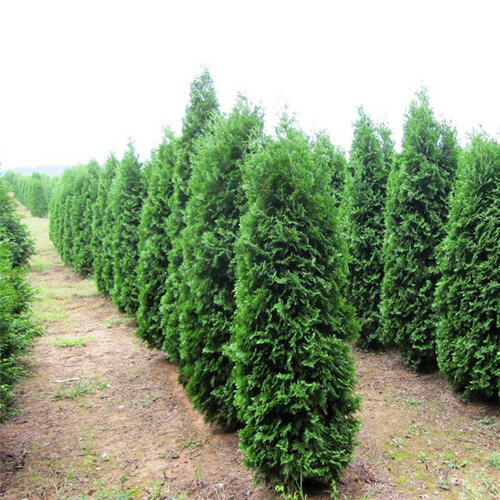
As a rule, the western Tuya has a pyramidal shape. In height, it reaches up to 20 m and a width of 4-5 meters. The needles of the tree are green, with a lighter shade from below. But there are also varieties, which are certainly appreciated by gardeners, who have a cover of a yellow shade or white and mottled. For example, the variety Reingold has yellow-orange needles. By winter, usually, the color of the needles becomes brown, and by spring it again acquires its habitual shade.
During the flowering period, yellow-green flowers can be found in the thuja. Also among the needles there are cones of brown color. They grow in places where they get more sun.
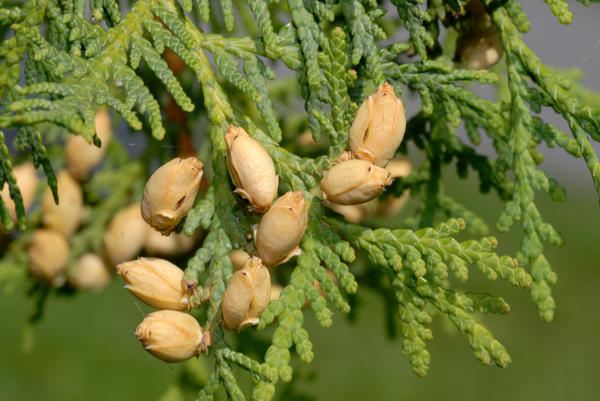
On the lower part of the tree, they practically do not exist. Especially if the thuja grows in a shady corner.
west
Western Tuva has a large number of varieties. Their diversity helps to transform garden plots. Add a flower bed, make a variety of garden trees. Also, a beautiful hedge of tui will look beautiful. For landscape design, both professionals and amateur gardeners use pyramidal, column-shaped, dwarf-shaped spherical shapes. This tree can be easily cut. With the help of garden scissors it is possible to engage in such art as a topiary. Here are the popular Western varieties:
- Degroot Spire (Degroot Spire) - has a unique shape of the crown. In width, this is perhaps one of the narrow columnar varieties. It is very popular in America;
- Column (Columna) - column-shaped variety up to 8 m high;
- Pyramidalas Compacta (Piramidalis Compacta) - conical variety has a dense thick crown. It is similar to the cultivar of Columna. It reaches a height of 10 m;
- thuja Douglas (Thuja occidentalis Douglasii pyramidalis) - has a pyramidal crown and a height of up to 15 m;
- Smaragd (Smaragd) - has a neat pyramidal shape. The color of the crown is green. It grows slowly;
- Salland - has a yellow color and a pyramidal shape;
- Yellow Ribbon - has a narrow pyramidal shape of the crown. Color golden. In the winter, it does not get dark. At the age of 10, the height is approximately 2 m;
- Reingold - The tree has an orange-yellow color. This type of trees is growing at a slow pace. At the age of ten, the height is 1 - 1.5 m;
- Danica (Danica) is a decorative variety. The height of a little less than a meter and a width of about 1 m. It has a spherical crown. Foliage is dark green. Resistant to frost;
- Golden Globe (Golden Globe) - is also a decorative variety. Has yellow-green color of needles. At the age of 10 years, reaches 1 m in height and as much in width. Tui of this variety is preferably planted in sunny places with sufficient moisture;
- Globosa (Globosa) - a shrub globular. The needles grow vertically. In height, adult thuja at the age of 10 years reaches 1.5 m and a width of 1 m;
- Mr. Bowling Ball - Thuya globose with dense needles. In the 10-year-old age it reaches a height of only 40 cm. In summer, the variety has a dark green color, by winter the color changes to gray-brown;
- Woodwardii is a winter-resistant dwarf variety with a light green color. At the age of 10 years has a width of only 40 cm. It resembles an ellipse in shape. Grows more in width than height;
- Little Gem (Little Gem) is a dwarf variety. Has a crown width of up to 2 m. Color in summer - a saturated green, in winter - brown;
- Stolvik is a dwarf variety. Has an asymmetric shape. It grows slowly. At 10 years of age, the width of the crown is only 1 meter. The color is dark green.
Among a large variety of varieties for landscape design, the "Smaragd" and "Danika" varieties are distinguished.
Touya Smaragd
Description: Thuya West Smaragd is a neat pyramid. The tree grows slowly. A total of 10 cm per year in height and up to 5 cm in width. During the whole year it has a dark green color. This variety is fond of beginning gardeners, since care of thuya smaragd is very simple. This tree is used to decorate the infield, as a supplement to the garden ensemble, for a change on the flower beds.
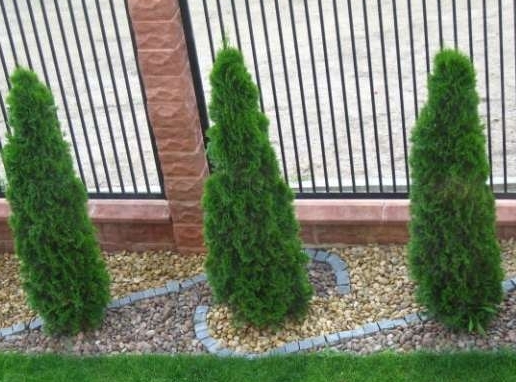
Tua Care Smaragd.For the Smaragd variety it is necessary to provide, albeit uncomplicated, but gentle care. Young trees are watered 1 time per week. It should be borne in mind that watering should not be less than once a month, so that the emerging root system does not dry up. For the same summer, the soil is mulched around the tuja. Top with peat or with hay. And on top of it, water spraying is carried out, so that the conifers develop better.
A young tuja falls in autumn with leaves or sawdust. So, the insulation is made the first few winters to protect the young shoots from freezing. Also, trees are protected from sunburn, which penetrate to the tree with the rays of the winter-spring sun. To do this, they are covered with paper caps, bags or fixed with gauze cuts with a stapler.
Fertilizers for thuja are introduced three times. In early April, in late May and in August. As a top dressing suitable means for conifers. Fertilizer for young trees is applied once a year for the first couple of years in a diluted form. Concentration should be halved, in order to protect the young root system from the biting of a large dose of top dressing.
Circumcision is performed three times a year (for adult trees). The first is done in the spring, to remove diseased and damaged branches. Then, during the summer, shorten the shoots so that they grow better.
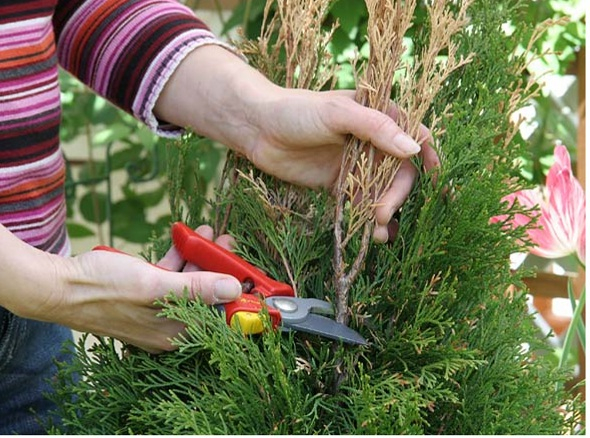
And the next cropping is done before winter.
Tui Danica
Its name was given by Danica Danica from the country in which she first brought out the variety - Denmark. This species of thuja, as already mentioned above, has a spherical shape and belongs to dwarf varieties. Interesting is the needles of Danica. The crown is dense, but the needles are soft, have scales. The branches are raised vertically.
Flowering for the Danika variety is not typical. Rarely you can meet and bumps on the thuja. As a rule, their size is 5-6 mm, and they have a rounded shape. His green color tuya Danika pleases the hosts throughout the year. They live long, more than a hundred years. This type of tui fits well in any landscape. It is placed on the Alpine hills, among the flower beds, next to the tuya of a larger variety.
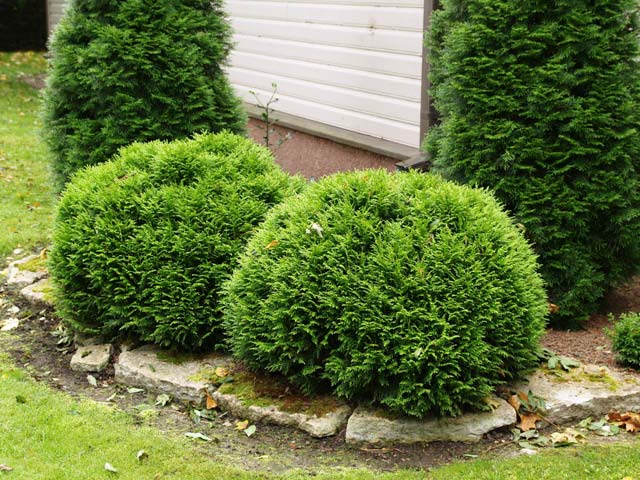
With proper care, they look quite in harmony with the surrounding plants.
Thuja western, landing
Before planting a western tuya, for example, the Danica variety, it is necessary to determine the landing site. It is desirable that this is a site with a moderate amount of sun and moisture. Sunlight should flow to the tree no less than 6 hours a day. Otherwise, the crown will be meager, and growth is slowed down.
The depth of the pit must be equal to the volume of the root coma. In this case, it is not advisable to leave the seedling in a cramped area. Prepare a small stock in the pit, lay the seedling in the soil, spread the roots and sprinkle with the earth. After you have sprinkled with thuju earth, you should have a small hole along the perimeter in the form of a hole. Thus, it will be more convenient for a young tree to receive water coming to it.
Landing of thuja in the ground is carried out without chemical fertilizer. A tree may have difficulties in adapting to new conditions. Therefore, the best solution for freshly planted thui is moderate watering and mulching. A peat layer is laid on top of the watered tree and the landing is made, exactly, like the planting of other varieties, is considered complete. Just remember that the height of the mulch layer should be at least 4-5 cm.
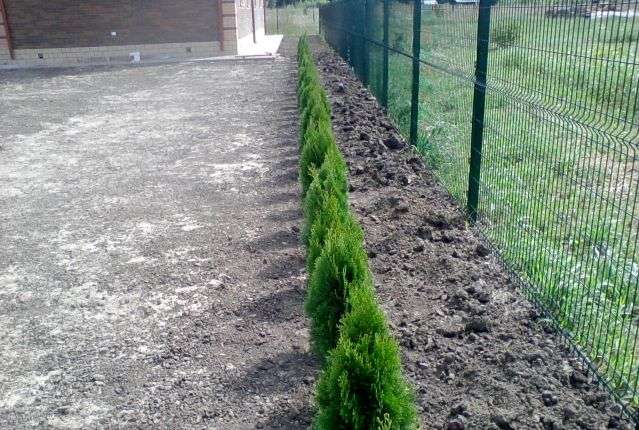
Thus, young thai will have a sufficient amount of moisture and minerals.
Useful advice on the content of thuja western
- If you do not know where to put thuya, then for Smuragd, the best solution is to decorate as a hedge along the fences. The Danika variety is suitable for disembarkation in an alpine hill, along paths or in a flower bed;
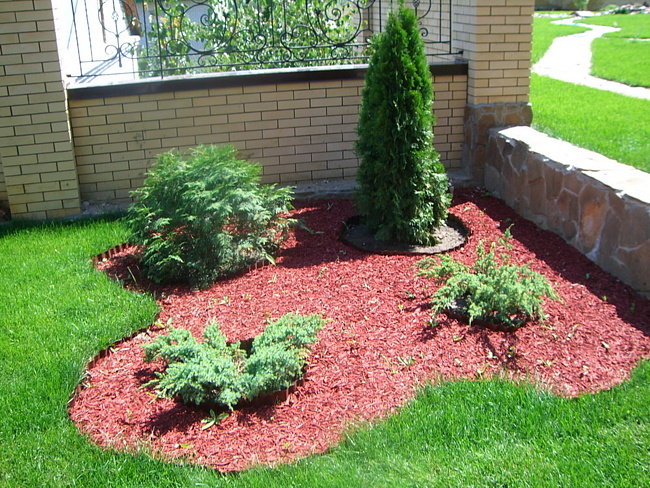
- To fully develop tui, a fertilizer is applied to the planting pit: deciduous humus, contents of compost pits or some part of peat. Fertilizer is laid over the drainage, then it is sprinkled with a layer of sand and only then the tree is planted;
- When planting thai in the ground, weekly watering should be observed. The first month the volume should be 10 liters. In a dry period, water 20 liters of water. Further, the amount of liquid is reduced;
- After you cover the plant for winter with a bag, it must be tied with a rope. If this is not done, then the accumulated snow can break branches of a young tree. If you can not tie a tree because of the peculiarity of the variety, then observe the accumulations and remove them in a timely manner;
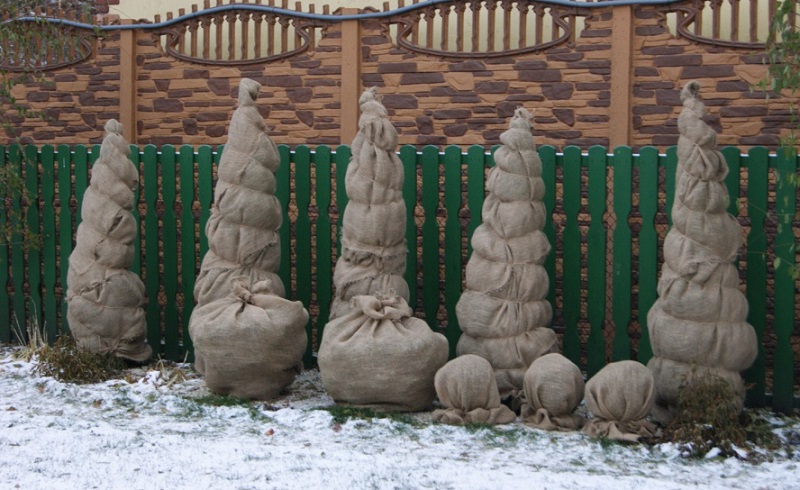
- It is possible to decorate it on your own. Depending on the variety and your preferences. Do it better in autumn and spring.
Here are some more recommendations of the expert on care for thui:
That's all the advice that should be observed when planting and caring for the western thuja. Some time after planting, this tree will grow, and will delight you with its lush crown. By following proper care, it will be your companion for life. After all, this tree is pleasant not only for its appearance, but also for its fragrance.
Be sure that you have chosen the right scenery!



















